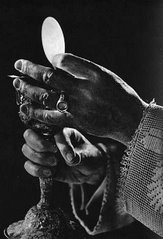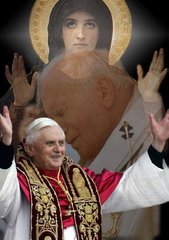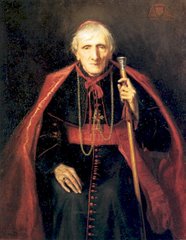
Saturday evening we endeavored out again with conflicting directions to try to find St. Nicholas of Myra, a Byzantine Catholic Church which celebrates the Eastern Rite. Without showering after a day at Universal Studios, we tried to disguise our stinky bodies with appropriate clean clothes - minus the Lutheran analogy. Walking into the quaint looking church’s narthex, we were greeted by a friendly usher who welcomed us. To my great appreciation he informed us of some liturgical differences we should know lest certain and imminent embarrassment.
To show the receiving of a blessing, the people make the sign of the cross opposite of the priest, where ‘Holy’ falls on the right shoulder and ‘Spirit’ on the left. Each time the Holy Trinity is referred to in the Divine Liturgy, either by name or when each Divine Person of the Trinity is mentioned, the sign of the cross is made with a slight bow. Throughout their St. John Chrysostom Liturgy, there is more verbal participation than in the Roman Rite. Also, the priest faces the altar and celebrates behind the open doors of the iconostasis.
Upon entering the nave, the first thing I noticed was the ornate iconostasis separating the earthly world from the sanctuary, the heavenly world. However, the iconostasis is also a symbol of unity; this is where the two worlds meet with icons of Saints, Mary, and Christ in between to show the means of our salvation. The iconostasis emphasizes the sanctuary as the “holy of holies,” its sacredness, and the mystery of God. The priest enters through the center doors, the Royal or Holy Doors, and the deacon can only enter on the side single doors. The action of the priest exiting the sanctuary through the iconostasis symbolizes his bringing the mystery of God to the people. Above the iconostasis on the back wall is a painting of the Last Supper, as it is a focal point of the Divine Liturgy. Also, the rest of the walls are either decorated with stained glass windows or icons. Even the chandeliers are beautifully decorated and contain small icons around their middles. The Church contained no statues as this is a tradition of the West.
The angels and Mary are reserved special devotion in the icons and Divine Liturgy. Gabriel, Michael, and Raphael are depicted on both the iconostasis and the wall behind it. Mary is pictured in icons, and she is honored as the Mother of Christ multiple times throughout the Divine Liturgy. The seraphim and cherubim are also mentioned as they glorify and praise God constantly. The seraphim are depicted in the iconic mural above and behind the sanctuary with Mary and child Jesus. Extending from the back of the tabernacle are two rods with sun-like ends representing the seraphim as well.
Father Sal Pignato spoke to us after the Divine Liturgy and shared with us some of the richness of the Eastern rite, which aided in this recounting of the experience. We are grateful to Father for celebrating the Divine Liturgy with us and the other people – mostly tourists – who attended.






No comments:
Post a Comment